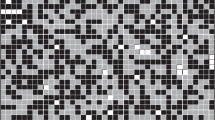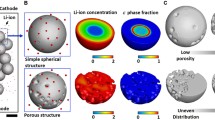Abstract
The active layer of a lithium-oxygen battery (LOB) cathode must have a complex structure consisting of two types of pores (macropores and mesopores). For successful operation of the cathode active layer during the LOB discharge, attempts are being made to create two types of pore clusters: a macropore cluster that provides the transport of oxygen to a zone, where the final product, lithium peroxide, is formed, and a mesopore cluster that guarantees the delivery of lithium ions. The structure of the cathode active layer composed of two types of clusters is optimized in model calculations. However, it from the experimental data, even after the actual implementation of these theoretical recommendations, that the LOB dimensional characteristics during the discharge (in particular, current density I, mA/cm2, and cathodic capacitance C, C/cm2) remain low. In the present work, a new type of cathode active layer structure was suggested: a regular biporous model. In this model, the channels for the supply with oxygen and lithium ions are separated from each other. This fact allows one to simultaneously and independently improve the operation of each of the two channels. The calculations showed a clear advantage of the active layers with this new structure. In particular, the current density i and cathode capacitance С raised to tens of mA/cm2 and about of a thousand of C/cm2.







Similar content being viewed by others
REFERENCES
Abraham, K.M., J. Electrochem. Soc., 1996, vol. 143, p. 1.
Bruce, P.G., et al., Nat. Mater., 2012, vol. 11, p. 19.
Tran, C., J. Power Sources, 2010, vol. 195, p. 2057.
Yang, X.-h., He, P., and Xia, Y.-y., Electrochem. Commun., 2009, vol. 11, p. 1127.
Laoire, C.O., Mukerjee, S., and Abraham, K.M., J. Phys. Chem. C, 2009, vol. 113, p. 20127.
Laoire, C.O., Mukerjee, S., and Abraham, K.M., J. Phys. Chem. C, 2010, vol. 114, p. 9178.
Ma, Z., Yuan, X., Li, L., Ma, Z.-F., Wilkinson, D.P., Zhang, L., and Zhang, J., Energy Environ. Sci., 2015, vol. 8, p. 2144.
Tarasevich, M.R., Andreev, V.N., Korchagin, O.V., and Tripachev, O.V., Prot. Met. Phys. Chem. Surf., 2017, vol. 53, p. 1.
Pan, W., Yang, X., Bao, J., and Wang, M., J. Electrochem. Soc., 2017, vol. 164, p. E3499.
Chirkov, Yu.G., Andreev, V.N., Rostokin, V.I., and Bogdanovskaya, V.A., Altern. Energy Ecol. (ISJAEE), 2018, nos. 4–6, p. 95.
Tarasevich, Yu.Yu., Perkolyatsiya: teoriya, prilozheniya, algoritmy (Percolation: Theory, Applications, Algorithms), Moscow: Editorial URSS, 2011.
Chirkov, Yu.G., Andreev, V.N., Rostokin, V.I., and Bogdanovskaya, V.A., Russ. J. Electrochem., 2019, vol. 55, no. 9, p. 860.
Sandhu, S., Fellner, J., and Brutchen, G., J. Power Sources, 2007, vol. 164, p. 365.
Dabrowski, T., Struck, A., Fenske, D., Maaß, P., and Colombi Ciacchi, L., J. Electrochem. Soc., 2015, vol. 162, pp. A2796–A2804.
Read, J., Mutolo, K., Ervin, M., Behl, W., Wolfenstine, J., Driedger, A., and Foster, D., J. Electrochem. Soc., 2003, vol. 150, p. A1351.
Edwards, C.H. and Penny, D.E., Differential Equations and Boundary Value Problems: Computing and Modeling, Pearson, 2008.
Goloskokov, D.P., Uravneniya matematicheskoi fiziki. Reshenie zadach v sisteme Maple (Equations of Mathematical Physics. Solving Problems in the Maple System), St. Petersburg: Piter, 2004.
Bogdanovskaya, V.A., Chirkov, Yu.G., Rostokin, V.I., Yemetz, V.V., Korchagin, O.V., Andreev, V.N., and Tripachev, O.V., Prot. Met. Phys. Chem. Surf., 2018, vol. 54, no. 6, p. 1015.
Funding
The work was supported by the Ministry of Science and Higher Education of the Russian Federation.
Author information
Authors and Affiliations
Corresponding authors
Additional information
Translated by E. Khozina
Rights and permissions
About this article
Cite this article
Chirkov, Y.G., Rostokin, V.I., Andreev, V.N. et al. A Regular Biporous Model of the Cathode Active Layer Structure of a Lithium-Oxygen Battery. Calculation of Overall Characteristics of the Cathode Active Layer. Prot Met Phys Chem Surf 56, 716–724 (2020). https://doi.org/10.1134/S2070205120030119
Received:
Revised:
Accepted:
Published:
Issue Date:
DOI: https://doi.org/10.1134/S2070205120030119




